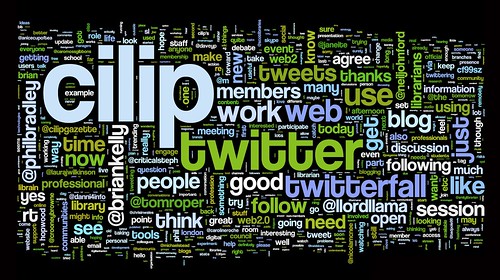
cilip2_full by Dave and Bry, on Flickr
I've been thinking about the CILIP 2.0 Council Open Session yesterday. First off, it was fascinating for me to attend an event like this on Twitter. Although I've followed events from hashtags before, as a relatively new Twitterer, never anything on this scale. The tools that were recommended (Twitterfall and Tweetdeck) worked well for me, although at times there was a bit of lag from Twitterfall so I found myself reverting to Twitter Search occasionally.
I did get some sense of what was happening in the room and a number of Twitterers were very generous in describing what was going on (see @tomroper or @janeite for running commentaries or @daveyp's transcript of the #cilip2 tag for more info).
I've seen some criticism of the Twitter stream as being hard to follow and the thought's or ideas not being coherent, which is interesting in itself. Yes, it's a challenge to put complex ideas into 140 characters but I beleive there are coherent streams (or conversations) within the tag. Perhaps it has as much to do with the number of participants as anything. The more people you have in a group, the looser the conversations tend to get. At least Twitter allowed a large number of people to attend remotely and the stream is there to be analysed/ picked over now. I'm sure some interesting threads will emerge.
What did the day achieve though? Well, I didn't pick up on any hard action or proposals. I can't see that any actual decisions were made by the CILIP top brass. But then I'm not sure that was what the event was about. I get the sense that it was more about CILIP Council *listening* to it's members. This is something I've never heard of before and I really think CILIP Council deserve a big hats-off for hosting the event.
I'd like to see CILIP provide a strong lead in this space. Personally I think they've some catching up to do, but listening and finding out more with events like yesterday's is a very good start.
The event got me wondering: actually, what do I want from CILIP with regards to Web 2.0? Do I want them to leap on the latest hot Web2.0 app? Well, partly. I'd like to see them take more interest in the tools that members are using and, if there is significant demand, engage with their users on those tools. But I think using the latest/ coolest tools in the Web2.0 toybox is a bit misleading. Web2.0, for me, is not about the specific applications it's more a way of being. Being open, encouraging participation, encouraging user generated content, concepts like creative commons etc. The big question for me really is not whether or not CILIP have an "official" Twitter account (although that would be nice!) but whether they are prepared to use Web2.0 to be more open and to provide a place for librarians to openly share their ideas and information.
By extension that means that we - the information profession - have to be more open in sharing our information and content. We have to contribute and get involved. Can we make CILIP2.0 a reality?


Yes, I too felt it was a largely positive experience, despite being a bit confusing to follwo, and a promising step forwards for CILIP members and officers.
ReplyDeleteI'll try and elaborate more in a future blog post on the official CILIP Blog Landscape too!
Please do come and use the unofficial continuation #CILIP2 wiki at:
http://cilip2unofficial.wikispaces.com/
I think you are right that a successful outcome from this meeting and process won't be the adoption by CILIP of particular tools, technologies, or even necessarily of web2.0, but instead a different way of thinking, so that the professional body for information professionals is not again caught napping by new methods of information dissemination and discovery but is instead leading, or at least at the forefront of, such developments in the future. This is important if nothing else for CILIP's own reputation as well as that of the profession it purports to represent.
ReplyDelete